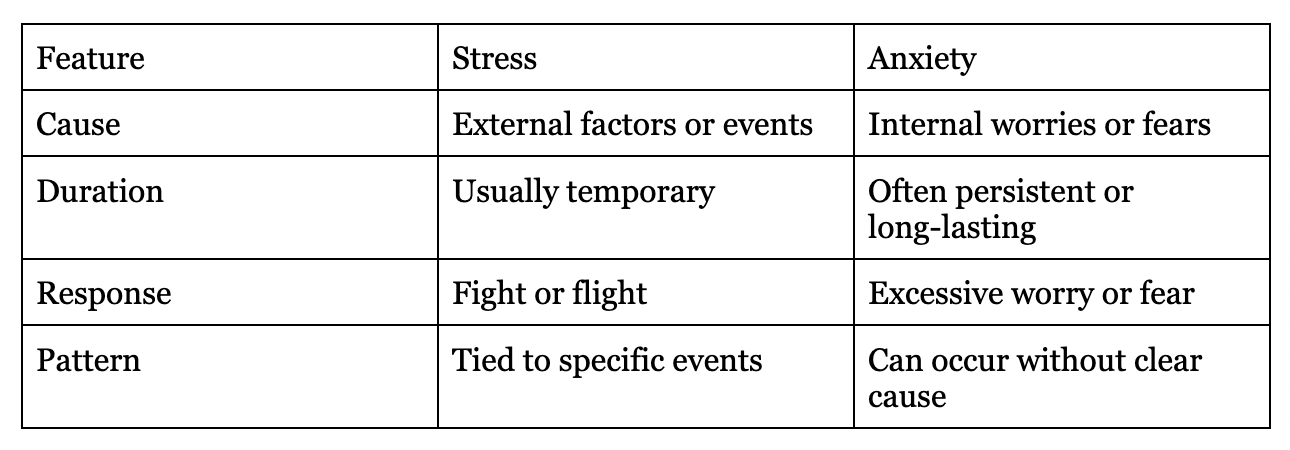Understanding the Key Differences Between Stress and Anxiety: A Comprehensive Guide
In today’s busy world, many people experience stress and anxiety without knowing the real difference. Recognizing how they differ helps you manage your mental health better. Confusing the two can lead to improper treatment or ignoring symptoms altogether. Did you know that anxiety disorders are the most common mental illnesses in the U.S., affecting 40 million adults? Understanding these conditions can make a big difference in your life.
What Is Stress? Understanding Its Nature and Impact
Stress is your body’s way of responding to external pressures or demands. It’s a normal reaction to things like deadlines, pressure at work, or personal issues. When you face a stressful event, your body releases hormones like adrenaline, preparing you to act. This is called the “fight or flight” response. Sometimes, short-term stress can motivate you to complete tasks or meet goals. But too much stress can hurt your health.
Types of Stress
- Acute Stress: This is a temporary response to a specific situation, like finishing a big project or missing a bus. It usually goes away after the event is over.
- Chronic Stress: This is ongoing stress that lasts for weeks or months. It can happen due to ongoing problems, like financial worries or relationship issues.
Real-world example: Feeling nervous before a presentation is acute stress. Constant worries about paying bills are chronic stress.
Physical and Emotional Symptoms of Stress
Common signs include headaches, tight muscles, irritability, and tiredness. Chronic stress can cause trouble sleeping, loss of appetite, and weaken your immune system. Experts say that persistent stress can lead to health problems if not managed.
When Stress Becomes a Problem
If stress stays for a long time, it can lead to burnout or mental health issues like depression. Managing stress is important. Ways to do this include exercising regularly, practicing mindfulness, or setting better time limits for tasks.
What Is Anxiety? Defining Its Characteristics and Types
Anxiety is different from stress because it involves persistent worry or fear, even when no immediate threat exists. Normal anxiety helps alert you to danger, but when it becomes excessive, it can take over your life.
Types of Anxiety Disorders
- Generalized Anxiety Disorder (GAD): Worrying excessively about many things every day.
- Panic Disorder: Sudden, intense episodes of fear with physical symptoms like a racing heart.
- Social Anxiety Disorder: Fear of social situations, making it hard to go to parties or speak in public.
- Phobias: Excessive fear of specific objects or situations, such as heights or spiders.
Real-world example: Someone with social anxiety might avoid parties despite wanting to socialize.
Symptoms of Anxiety
Psychologically, anxiety can cause your mind to race, make you restless, or worry too much. Physical signs include rapid heartbeat, sweating, trembling, and dizziness. Experts say recognizing these symptoms early can make it easier to seek help.
Anxiety’s Impact on Daily Life
Persistent anxiety can affect relationships, work productivity, and overall happiness. Treatments include therapy, medication, or lifestyle changes like exercise and meditation.
Key Differences Between Stress and Anxiety
Here’s a quick comparison:

Common misconceptions: Many think stress and anxiety are the same. In reality, stress comes from outside forces, while anxiety is more about how your mind reacts.
Tip: To tell which one you have, ask yourself if you’re reacting to a specific event or feeling worried constantly about many things.
How to Manage and Differentiate Stress and Anxiety
Managing stress involves relaxation, regular exercise, and good routines. Try deep breathing or taking breaks when feeling overwhelmed. Managing anxiety often requires different tools like therapy, mindfulness practices, or asking a professional for help.
- Stress relief tips: Walking, listening to music, or journaling.
- Anxiety management: Practicing meditation, talking to a therapist, or using relaxation techniques.
Self-Assessment Tips
- Are your feelings tied to specific events? You might be experiencing stress.
- Do you worry constantly even without a clear reason? That could be anxiety.
- When symptoms last for weeks or interfere with daily life, seek professional help.
Resources for Support
Apps like Headspace, BetterHelp, or local support groups can assist. Hotlines such as the National Alliance on Mental Illness offer immediate help.
Conclusion
Understanding the difference between stress and anxiety is vital for managing your mental health. Recognizing symptoms early allows you to take action and seek help if needed. Remember, practicing mindfulness daily can help you better identify and cope with both stress and anxiety. Don’t ignore persistent feelings—professional support can make a difference in your well-being.
References
- American Psychological Association. (2023). Understanding stress and anxiety.
- Anxiety and Depression Association of America. (2023). Facts & Statistics.
- Mayo Clinic. (2023). Anxiety Disorders overview.






